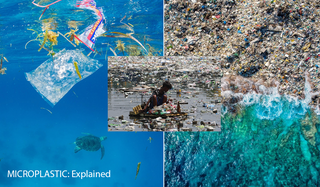- “Microplastic”
A small plastic particle that measures less than 5mm in size.
These invisible particles are found everywhere, from all corners of the ocean to the air we breathe. The inevitable by-product of producing a highly accessible and affordable material from hazardous chemicals, on mass... the impact from plastic trash "break-down" is causing great concern for both environment and our health.
Microplastics are derived from a variety of sources, including:
- the breakdown of larger plastic items
- the shedding of synthetic clothing fibres
- the use of personal care products such as toothpaste and exfoliating scrubs that contain microbeads.
Once they enter the environment, they do not ever completely biodegrade, instead continue to accumulate and leak toxic chemicals, everywhere they go.
Microplastics in our world
We are only beginning to understand the impact plastic is causing to our environment, microplastic contamination now appears as one of the world's main environmental concerns.
Micro-plastics are e v e r y w h e r e...

Microplastics have an excellent ability to absorb toxic chemicals, such as PCBs and DDT, which when transferred up the food chain - can negatively impact both animal & human health.
Polychlorinated Biphenyl "PCBs"
Man-made chemical mixture, up to 209 individual chlorinated compounds - Highly carcinogenic, banned in the United States by the Toxic Substances.
Wastes from the manufacturing process that contained PCBs were often placed in dump sites or landfills.
Occasionally, accidental spills and leaks from these facilities or transformer fires could result in PCBs entering the environment.
PCBs can be found worldwide. Easily absorbed by Microplastics, waiting to be ingested by fish, larger animals and eventually - us!
Dichlorodiphenyltrichloroethane "DDT"
Classified persistent organic pollutant, the world's first known pesticide, infamous for its environmental impacts. One of the most controversial chemical compounds in history, this compound penetrates soil and remains there for 30+ years!
While it is effective as an insecticide, its potent toxicity isn’t limited to insects. Banned outright in 1970s in many countries. Widely used in agriculture, a total of 1.8 million tonnes produced since the 1940s. Human exposure to DDT likely occurs from eating meat, fish and dairy.
Health hazards associated with DDT:
- Endocrine Disruptor.
- Human Carcinogen "cancer causing".
- Classified toxic substance by US NTP.
- Interference with regular thyroid function in pregnant women.
- Linked to higher risk of developing autism in children.
- Case for autoimmune disorders.
Now might be a good time to consider ditching plastic drink bottles, if not for the environment, for your health!
Choose Sustainable! We have BPA free food grade stainless steel, double walled & vacuum sealed - fully insulated to keep drinks hot or cold water bottles from Australia owned and operated partner, Sinclo - see collection.
Life cycle of Microplastics:

-
Microplastics are widely used in products such as cosmetics, clothing, and cleaning products.
-
Microplastics in the ocean come from a variety of sources such as broken-down larger plastic debris, microbeads in personal care products, and microfibers from synthetic clothing.
-
They are ingested by marine animals, causing harm to their digestive systems and potentially entering the human food chain through seafood consumption.
-
They are widespread and have been found in every ocean and in remote areas, such as the Arctic.
-
Microplastics also absorb toxic chemicals and pollutants, making them even more harmful when ingested.
-
Efforts to address the problem of microplastics in the ocean include reducing plastic use, properly disposing of waste, and researching alternatives to plastic products.
Microplastic and the Ocean
Microplastics have a significant impact on the ocean and marine life. Disrupting the oceans' balanced ecosystem - frequently ingested by marine life, causing physical damage and disruption to their digestive systems as well as health issues for bigger fish and so on, up the food chain.
Some of the effects of microplastics in the ocean include:
- Ingestion: Marine animals, such as fish and birds, can accidentally ingest microplastics, which can lead to physical injury and poisoning.
- Smothering: Microplastics can cover and smother habitats such as coral reefs, disrupting their ability to function and thrive.
- Chemical contamination: Microplastics can absorb and release toxic chemicals, such as persistent organic pollutants, which can harm marine life and ecosystems.
- Spread of invasive species: Microplastics can serve as a transport mechanism for invasive species, leading to changes in local biodiversity and ecosystem dynamics.
- Accumulation in marine food webs: Microplastics can transfer up the food chain, potentially affecting human health through contaminated seafood.
Addressing the problem of microplastics in the ocean requires a combination of reducing plastic waste and improving waste management practices to prevent plastic from entering the ocean.

Microplastic & Human Health
The impact of microplastic on human health is not completely understood, studies know the release of toxic chemicals negatively impact reproductive and developmental health.
Today, microplastics have been found in tap water, bottled water, and even the air we breathe, leading to potential inhalation and ingestion of these particles.
Yes, microplastics has been found in human bodies!
Studies show the presence of microplastics in human blood, urine and in some cases, microplastics have been detected during foetal development.
Shop Eco Store
Sustainable Brands & Ethical Australian Clothing,
Clean Beauty, Organic Skin Care, Eco Friendly Products.
See our strict sustainability criteria: here
How we can put a stop to the spread!
The problems surrounding these micro plastic particles have become increasingly urgent, it is up to individuals and businesses to take action to reduce their impact.
One of the most effective ways to reduce the presence of microplastics is to reduce the use of single-use plastic items, such as straws and plastic bags, and to recycle whenever possible.
Additionally, avoiding products that contain microbeads and opting for natural, biodegradable alternatives can also greatly reduce the presence of microplastics.
Businesses can play a role in reducing microplastics by incorporating more sustainable practices into their operations. For example, many companies are now using biodegradable packaging materials, such as plant-based plastics, to reduce their impact on the environment.
Additionally, companies should work greener and ensure that their products, such as synthetic/ disposable clothing, are produced in a more environmentally friendly manner.
Governments also have a role to play in reducing the impact of microplastics. Regulations and bans on the use of microbeads in personal care products, as well as mandatory recycling programs, can help to significantly reduce the amount of microplastics in the environment.

Avoidable Plastic: Fast Fashion, Synthetic clothing & Microplastics
Synthetics material: made by humans through chemical synthesis. Made only from polymers found in natural gas and the by-products of petroleum.
Clothes made from synthetic “man-made” fibres; polyester, nylon, etc ALL inevitably release microplastics into the environment.
How? Shedding.
This usually occurs through wash and wear of synthetic clothing, the fibres break down, disintegrating from the garment and enter our water supply, eventually finding their way to end our oceans and other bodies of water.
To reduce the release of microplastics, it is recommended to wash synthetic clothing less frequently and in colder water.
To mitigate future damage, choosing natural fibres such as cotton or wool instead of synthetic fibres will significantly help reduce further impact to our environment!
Shop: Sustainable Brands, Ethical Australian Clothing & Eco Friendly Products
How-to: properly care for clothing:
- Read the care label: Look for symbols and instructions on how to wash, dry, iron, and bleach your clothes.
- Sort clothes: Sort clothes by color, weight, and type to avoid color transfer and damage.
- Wash clothes: Use the right temperature and cycle recommended on the care label. Avoid overloading the washing machine to prevent damage to clothes.
- Dry clothes: Use a dryer or air-dry clothes, following the care label instructions. Avoid over-drying or exposing clothes to direct sunlight, which can cause fading and damage.
- Iron clothes: Use the right temperature and steam setting recommended on the care label. Avoid ironing embellishments or printed areas, which can be damaged.
- Store clothes: Store clothes in a dry, cool place, and avoid cramming them into drawers or closets. Fold or hang clothes to prevent creases and damage.
- Spot clean: Attend to spills and stains as soon as possible to prevent them from setting in. Use a mild soap solution or specialized stain remover.
Remember, proper care will help extend the life of your clothes, and keep them looking and feeling wonderful!


